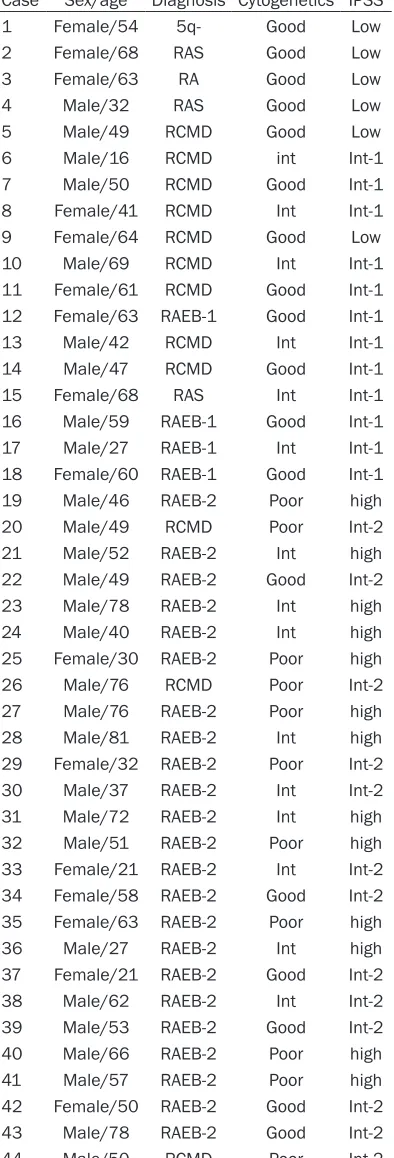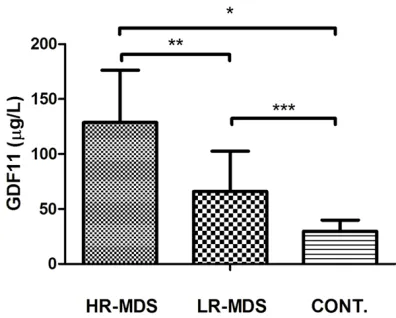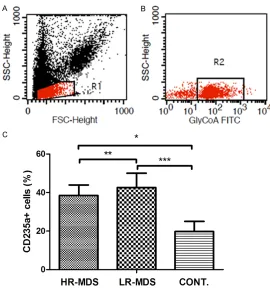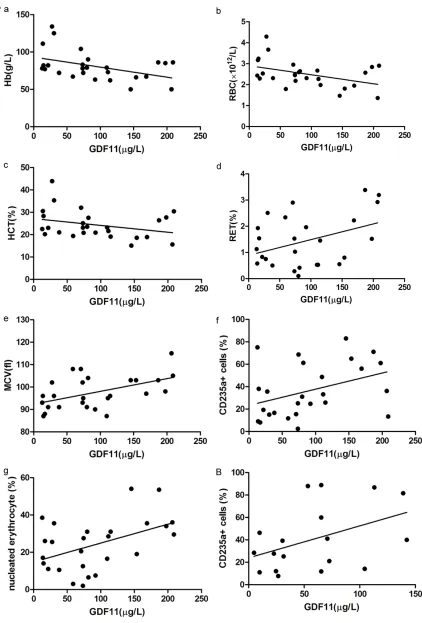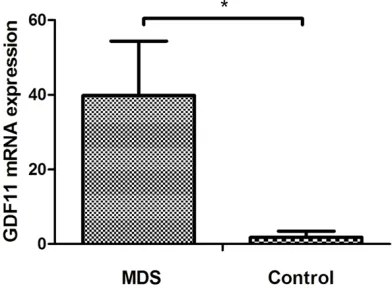Original Article
GDF11 is increased in patients with myelodysplastic
syndrome
Yu Han, Gaochao Zhang, Huaquan Wang, Rong Fu, Limin Xing, Lijuan Li, Huijuan Jiang, Wei Zhang, Jinglian Tao, Zonghong Shao
Department of Hematology, General Hospital, Tianjin Medical University, Tianjin 300052, China Received January 26, 2016; Accepted April 23, 2016; Epub June 1, 2016; Published June 15, 2016
Abstract: Objective: To explore the role of growth differentiation factor 11 (GDF11) in patients with myelodysplastic syndrome (MDS) in erythropoietic functions. Methods: The serum GDF11 in MDS patients was measured using an enzyme-linked immunosorbent assay. The percentage of nucleated erythroid cells (CD235a) in bone marrow was detected via flow cytometry. The correlation between these changes and erythropoietic function were evaluated. GDF11 mRNA expression in bone marrow mononuclear (BMMNC) was detected through real time polymerase chain reaction. Results: The concentration of GDF11 in high-risk MDS patients was significantly higher than that in low-risk MDS patients and higher than that in healthy controls. The concentration of GDF11 in low-risk MDS patients was significantly higher than that in healthy controls. In high-risk MDS patients, the expression of GDF11 was negatively correlated with hemoglobin, red blood cells, and hematocrit and positively correlated with reticulocyte, mean cor-puscular volume, CD235a+ cells, and nucleated erythrocytes in bone marrow. In low-risk MDS patients, the expres-sion of GDF11 was positively correlated with CD235a+ cells in bone marrow. The mRNA expresexpres-sion of GDF11 of BMMNC in the MDS group was higher than that in the control group. Conclusion: GDF11 was increased in patients with MDS and negatively correlated with late erythropoiesis.
Keywords: Myelodysplastic syndrome, growth differentiation factor 11, anemia
Introduction
The myelodysplastic syndromes (MDS) are a group of clonal hematopoietic stem cell diseas-es characterized by cytopenias, dysplasia in one or more of the major myeloid cell lines, ineffective hematopoiesis, and increased risk of development of acute myeloid leukemia (AML). Anemia is the most frequent manifesta-tion in MDS patients [1]. Erythropoiesis is a multistep process by which erythroid precursor cells proliferate and differentiate into mature red blood cells (RBCs). Under the regulation of erythropoietin (EPO), committed progenitor cells divide and differentiate into proerythro-blasts. These cells further mature through a series of normoblast stages before undergoing enucleation to form reticulocytes and mature RBCs [2]. MDS are characterized by ineffective erythropoiesis that can lead to overproduction of EPO, erythroid hyperplasia, and bone mar-row expansion, as well as dysregulated iron metabolism, including suppressed hepcidin
production. The efficiency of recombinant
human EPO in MDS patients’ anemia is approxi-mately 40%. Furthermore, patients with refrac-tory anemia with ringed sideroblasts or patients who have high levels of EPO in the blood often respond poorly to recombinant human EPO therapy [3].
Growth differentiation factor 11 (GDF11) is a
ligand of the transforming growth factor-β superfamily (TGF-β). At present, in mammals,
more than 40 members of this superfamily are recognized, and they are divided into several
subcategories that include TGF-βs, GDFs, bone morphogenic proteins, Mϋllerian inhibitory fac
-tors, activins, and inhibins. Ligands of TGF-β,
phosphory-lation and signaling may play a role in condi-tions of ineffective erythropoiesis, as has been shown in bone marrow biopsies of patients with
Hematology Department of General Hospital of Tianjin Medical University were enrolled in this study from September 2014 to June 2015. There were 28 males and 16 females, and the median age was 52 (range, 16 to 81) years. According to WHO criteria, these included 1 patient with refractory anemia, 3 with refracto-ry anemia with ringed sideroblasts, 12 with refractory cytopenia with multilineage dyspla-sia (RCMD), four with refractory anemia with excess blast-1, 23 with refractory anemia with excess blast-2, and 1 with MDS associated with isolated del (5q). Based on the International Prognostic Scoring System for MDS, these samples were divided into groups: low-risk groups (low and intermediate-1 [INT-1]) and high-risk groups (high and intermediate-2 [INT-2]). Among these patients, 6 were at low risk (0), 12 at INT-1 risk (0.5-1.0), 13 at INT-2 risk
(1.5-1.0) and 13 at high risk (≥2.5). In general,
the low-risk group comprised 18 cases and the high-risk group comprised 26 cases. According to the severity standards of anemia, there were 3 normal, 6 mild (hemoglobin [Hb: 90-110 g/L]), 31 moderate (Hb: 60-90 g/L), and 4 severe (Hb: 30-60 g/L) cases. These patients were separated into two groups: the normal/ mild anemia group and the moderate/severe anemia group (Table 1). Ten healthy blood donors were selected as controls, including 2 men and 8 women, with a median age of 26 (range, 25-30) years.
Enzyme-linked immunosorbent assay
The levels of plasma GDF11 were measured using a human enzyme-linked immunosorbent assay kit (Cloud-Clone USCN, USA).
Quantity of erythropoiesis in bone marrow
Erythroid cells (CD235a+) were identified using flow cytometry. Herein, 100 µL of whole bone marrow was immunostained using
fluorophore-10 Male/69 RCMD Int Int-1
11 Female/61 RCMD Good Int-1 12 Female/63 RAEB-1 Good Int-1
13 Male/42 RCMD Int Int-1
14 Male/47 RCMD Good Int-1
15 Female/68 RAS Int Int-1
16 Male/59 RAEB-1 Good Int-1
17 Male/27 RAEB-1 Int Int-1
18 Female/60 RAEB-1 Good Int-1
19 Male/46 RAEB-2 Poor high
20 Male/49 RCMD Poor Int-2
21 Male/52 RAEB-2 Int high
22 Male/49 RAEB-2 Good Int-2
23 Male/78 RAEB-2 Int high
24 Male/40 RAEB-2 Int high
25 Female/30 RAEB-2 Poor high
26 Male/76 RCMD Poor Int-2
27 Male/76 RAEB-2 Poor high
28 Male/81 RAEB-2 Int high
29 Female/32 RAEB-2 Poor Int-2 30 Male/37 RAEB-2 Int Int-2
31 Male/72 RAEB-2 Int high
32 Male/51 RAEB-2 Poor high
33 Female/21 RAEB-2 Int Int-2 34 Female/58 RAEB-2 Good Int-2 35 Female/63 RAEB-2 Poor high
36 Male/27 RAEB-2 Int high
37 Female/21 RAEB-2 Good Int-2
38 Male/62 RAEB-2 Int Int-2
39 Male/53 RAEB-2 Good Int-2
40 Male/66 RAEB-2 Poor high
41 Male/57 RAEB-2 Poor high
42 Female/50 RAEB-2 Good Int-2 43 Male/78 RAEB-2 Good Int-2
[image:2.612.92.289.92.671.2]conjugated monoclonal antibodies: CD235a-FITC, and mouse isotype control monoclonal antibody (Becton Dickinson [BD], Franklin Lakes, NJ, USA) in TruCount tubes (BD), fol-lowed by red blood cell lysis in 1.0 mL of FACS RBC lysing solution (BD). Samples were acquired on a FACSCalibur (BD) and analyzed using CellQuest version 3.1 (BD).
Real-time quantitative transcriptase-poly-merase chain reaction (Q-PCR)
Bone marrow mononuclear cells (BMMNCs) were separated from fresh heparinized bone marrow samples (2 mL). Total RNA of BMMNCs was extracted using TRIzol reagent (Invitrogen Life Technologies, USA). The reverse transcrip-tion reactranscrip-tions to cDNA were performed using the QIAGEN OneStep RT-PCR Kit (QIAGEN, Germany). The gene expressions were
quanti-fied by Q-PCR (SYBR Green, ABI PRISM-7500
Sequence Detection system, USA). The primer sequences were as follows: GAPDH forward 5’-GCA CCG TCT AGG CTG AGA TG-3’, reverse 5’-TGG TGA AGA CGC CAG TGG T-3’; GDF11 for-ward 5’-TGC GCC TAG AGA GCA TCA AGT-3’, reverse 5’-CCC AGT TAG GGG TTT CAG TCG T-3’.
The relative quantification (RQ) of gene expres -sion used 2-ΔΔCt method (ΔΔCt= (Ct
target gene-Ct GAP-DH)patients-(Cttarget gene-CtGAPDH)control).
Collection of clinical data
The complete blood counts (CBC) of the patients and controls were collected, including RBCs, Hb, reticulocyte, hematocrit (Hct), mean
corpuscular volume (MCV), mean corpuscular hemoglobin (MCH), and mean corpuscular-hemoglobin concentration (MCHC). Nucleated erythroblasts in bone marrow were calculated by two hemato-pathologists.
Statistical analysis
All analyses were performed using SPSS Version 21.0 software (SPSS Science). Data were presented as mean ± SD. The Student t
test was used for two independent groups. The Pearson correlation test was used for correla-tion analysis. A P value of <0.05 was
consid-ered statistically significant.
Results
GDF11 was increased in the plasma of MDS patients
The concentration of GDF11 in high-risk MDS
patients (128.67±47.62 μg/L) was significantly
higher than that in low-risk MDS patients
(65.96±36.55 μg/L, P<0.01) and higher than that in normal controls (29.76±10.10 μg/L,
P<0.01). The concentration of GDF11 in
low-risk MDS patients was significantly higher than
that in normal controls (P<0.05) (Figure 1).
GDF11 was elevated in the plasma of severe/ moderate anemia MDS patients
The concentration of GDF11 in
severe/moder-ate anemia MDS patients (80.97±9.94 μg/L)
was higher than that in normal controls/mild
[image:3.612.89.287.70.229.2]anemia MDS patients (66.82±19.52 μg/L).
[image:3.612.325.523.72.214.2]Figure 1. Levels of plasma GDF11 in high risk MDS (n=26), low risk MDS (n=16) and healthy controls (n=10). (*P<0.01, **P<0.05, ***P<0.05). HR-MDS: high risk MDS; LR-MDS: low risk MDS.
However, there was no statistically significant
difference between the groups (P>0.05) (Figure 2).
CD235a+ cells increased in the bone marrow of patients with MDS
The percentage of CD235a+ cells was 38.49%±5.42% in the high-risk group and 42.64%±7.36% in the low-risk group, and both
were significantly higher than in the controls
(19.76±5.27%; both P<0.05). There was no
sta-tistically significant difference between the
[image:4.612.90.360.68.358.2]high-risk group and the low-risk group (P>0.05;
Figure 3).
GDF11 correlated with erythropoiesis in MDS patients
In high-risk MDS patients, the expression of GDF11 was negatively correlated with Hb, RBC,
and Hct in peripheral blood (r=-0.437, -0.430,
The number of RBCs remains relatively steady through erythropoiesis and destruction. When this equilibrium is disrupted, anemia is the result. The body will activate a series of stress responses to compensate for the drop in Hct and Hb. The proliferation and differentiation of erythroid precursor cells depends on stem cell factor and EPO, but not late-stage erythroid cells. The anemia observed in MDS patients is characterized by ineffective erythropoiesis and excess apoptosis of premature RBCs that can lead to overproduction of EPO. Furthermore, some patients with MDS are not sensitively responsive to EPO [5]. Therefore, it is urgent to explore other mechanisms regulating late-stage erythropoiesis.
The TGF-β superfamily is a potential regulator
of EPO and iron metabolism, including GDF11 and GDF8. Suragani et al. [4] reported that GDF11-ActRIIB-Smad2/3 signaling plays a key Figure 3. The percentage of CD235a+ cells in bone marrow of high risk
MDS (n=26), low risk MDS (n=16) and healthy controls (n=10). A. Flow gates BMMNC with SSC and FSC. B. Flow gates CD235a+ cells with GlyCoA-FITC antibody. C. The percentage of CD235a+ cells in bone mar-row of high risk MDS and low risk MDS are higher than that of healthy controls. (*P<0.01, **P>0.05, ***P<0.01). HR-MDS: high risk MDS; LR-MDS: low risk MDS; BMMNC: bone marrow mononuclear cells.
tively correlated with CD235a+
cells in bone marrow (r=0.429,
p<0.05), and not correlated with Hb, reticulocytes, RBCs, MCHC, MCV, MCH, Hct, or nucleated erythroblasts (all p>0.05) (Figure 4B).
GDF11 mRNA was overex-pressed in BMMNCs of MDS patients
The relative expressions of GDF- 11 mRNA in the MDS group (39.82±14.55) was higher than that in the control group (1.84± 0.64, P<0.01) (Figure 5).
role in regulating the proliferation and differen-tiation of late-stage RBCs. Additionally, the lev-els of plasma GDF11 in MDS patients and
NUP98-HOX13 in MDS mice were significantly
higher than in normal controls. ACE-536 (human) and RAP-536 (mice) function as ligand traps to block the interaction of GDF11 with activin receptors on developing normoblasts and consequently promote the proliferation and differentiation of late-stage RBCs in nor-mal and anemic patients or mice, thus increas-ing the levels of RBC and Hb. Dussiot et al. [6] studied thalassemia, another disease of inef-fective erythropoiesis. Expression of GDF11 was increased in splenic erythroblasts from thalassemic mice and accompanied with the
addition of ligands of the TGF-β superfamily,
including activin receptor type I (ALK4/5) and type II (ActR IIA and ActR IIB). Activation of GDF11 increased reactive oxygen species and the amount of erythroid precursor cells. Abnormal GDF11 expression blocked terminal erythroid differentiation, which leads to ane-mia. ACE-011, a recombinant human fusion protein containing the extracellular domain of the human ActR IIA, binds to and inhibits activin
and other members of the TGF-β superfamily.
GDF11 inactivation decreases oxidative stress, resulting in increased terminal erythroid differ-entiation. Inactivation of GDF11 also corrects the abnormal ration of immature/mature eryth-roblasts by inducing apoptosis of immature
patients are significantly higher than in normal
controls. The expression of GDF11 was associ-ated with disease stage and degree of anemia. GDF11 expression is much higher when a patient is in a high-risk state or has severe ane-mia. The levels of GDF11 were negatively cor-related with erythropoiesis, especially in the high-risk group. The expression of GDF11 was negatively correlated with Hb, RBC, and Hct, and positively correlated with reticulocyte, MCV, CD235a+ cells, and nucleated erythro-cytes. Therefore, we speculated that the over-expression of GDF11 may be involved in the pathogenesis of anemia in MDS patients. Studies have demonstrated that GDF11 links with activin receptor IIa/IIb on erythroid differ-entiation, activating and thus bonding with a type I receptor, ALK4 or ALK5. Then, this recom-binant protein initiates phosphorylated Smad2/ 3, which decreases erythropoiesis and differ-entiation, especially the late-stage erythroid, thus leading to refractory anemia [4]. It may be helpful to treat ineffective erythropoiesis by
inhibiting GDF11 and receptors specifically so
as to reduce Smad2/3 signaling. An open-label, Phase 2 study of ACE-536 in transfusion-de- pendent patients with low or intermediate-1
risk MDS confirmed its therapeutic effect. After
treatment, 6 of 7 patients with low transfusion burden became transfusion independent. Six of nineteen patients with high transfusion bur-den saw a reduction in the frequency of trans-fusion, and 5 of 6 patients became
indepen-dent [8]. The theory was also confirmed by the
study of ACE-011 in patients with low or inter-mediate-1 risk MDS requiring transfusion. Of
the 53 patients evaluable for efficacy, hemato -logical improvement was observed in 21 (40%). Eight of nine patients with low transfusion bur-den showed red cell count increases. Of these, 6 patients became transfusion independent. Nineteen of forty-four patients with high trans-Figure 5. GDF11 mRNA expression of BMMNCs of
[image:6.612.91.287.135.281.2]fusion burden had responses. Five patients became transfusion independent. Increases in platelet and neutrophil levels were observed in some patients with baseline thrombocytopenia and neutropenia, respectively [9].
GDF11 is not only a regulator of hematopoiesis, but also a rejuvenation factor in other systems. By joining the circulatory system of an old mouse to that of a young mouse, scientists have produced some remarkable results. In the heart, brain, muscles, and almost every other tissue examined, the blood of young mice appears to bring new life to ageing organs [10]. Another study reported that direct infusions of
GDF11 alone were sufficient to physically
increase the strength and stamina of muscles, as well as to reverse DNA damage inside mus-cle stem cells [11]. Therefore, GDF11 received wide attention as having a “youth” factor [12-14]. However, when another laboratory attempt-ed to reproduce these experiments they pro-duced entirely different results. They showed that the levels of GDF11 increased during age-ing and that it exhibited inhibitory functions on myogenesis and muscle regeneration. Given the data in humans showing an age-related increase, GDF11 could be a target for pharma-cologic blockade to treat age-related disorders [15]. However, Poggioli et al. [16] disagreed with this result. Their results showed circulating GDF11/8 levels decline with age. GDF11 can increase the ratio of erythroid precursor cells and block the differentiation and maturation of late-stage RBCs in MDS and thalassemia. Thus, we deduced that GDF11 could promote early-stage cell regeneration into other tissues. However, it needs further exploration to deter-mine whether early-stage cells can differenti-ate and mature into terminal and functional cells. The main reason for these different results was the different methods of detection. When the body was responding to stress, was GDF11 overexpression a protective mecha-nism? If the overexpression of GDF11 in MDS patients leads to abnormal late-stage erythroid differentiation and maturation, was premature apoptosis a protective mechanism? Can ACE-536 or ACE-011 increase the transformation from MDS to AML? The effective ratio of ACE-536 or ACE-011 in treating anemia was approx-imately 40% in low transfusion burden patients, while high transfusion burden patients had a lower response ratio. Therefore, we inferred
that apart from the abnormal levels of GDF11, there must be other reasons (for example, clon-al hematopoietic stem cells inhibiting hemato-poiesis) for anemia in MDS.
In conclusion, GDF11 levels are high in MDS patients. The expression of GDF11 is associat-ed with disease stage and degree of anemia. The levels of GDF11 are correlated with eryth-ropoiesis. Treatments targeting GDF11 may help to improve anemia in patients with MDS.
Acknowledgements
This project is partly supported by The National Natural Science Foundation of China (No. 81170472, 81400088, 81570111, 81500- 101), Application Bases and Advanced Te- chnology Research Program of Tianjin (No. 14JCYBJC27200, 09JCYBJC11200).
Disclosure of conflict of interest
None.
Address correspondence to: Huquan Wang and Zonghong Shao, Department of Hematology, Gene- ral Hospital, Tianjin Medical University, 154 Anshan- dao, Heping district, Tianjin 300052, China. Tel: 86-22-60817111; Fax: 86-22-60362085; E-mail: wanghuaquan@tmu.edu.cn (HQW); shaozonghong@ sina.com (ZHS)
References
[1] Tefferi A, Vardiman JW. Myelodysplastic syn-dromes. N Engl J Med 2009; 361: 1872-1885. [2] Grover A, Mancini E, Moore S, Mead AJ,
Atkinson D, Rasmussen KD, O’Carroll D, Jacobsen SE, Nerlov C. Erythropoietin guides multipotent hematopoietic progenitor cells to-ward an erythroid fate. J Exp Med 2014; 211: 181-188.
[3] Hellström-Lindberg E, Ahlgren T, Beguin Y, Carlsson M, Carneskog J, Dahl IM, Dybedal I, Grimfors G, Kanter-Lewensohn L, Linder O, Luthman M, Löfvenberg E, Nilsson-Ehle H, Samuelsson J, Tangen JM, Winqvist I, Oberg G, Osterborg A, Ost A. Treatment of anemia in my-elodysplastic syndromes with granulocyte col-ony-stimulating factor plus erythropoietin: re-sults from a randomized phase II study and long-term follow-up of 71 patients. Blood 1998; 92: 68-75.
tivin receptor IIA ligand trap corrects ineffec-tive erythropoiesis in β-thalassemia. Nat Med 2014; 20: 398-407.
[7] Iancu-Rubin C, Mosoyan G, Wang J, Kraus T, Sung V, Hoffman R. Stromal cell-mediated inhi-bition of erythropoiesis can be attenuated by Sotatercept (ACE-011), an activin receptor type II ligand trap. Exp Hematol 2013; 41: 155-166. [8] Platzbecker U, Germing U, Giagounidis A, et al.
ACE-536 Increases Hemoglobin and Reduces Transfusion Burden in Patients with Low or Intermediate-1 Risk Myelodysplastic Syndro- mes (MDS): Preliminary Results from a Phase 2 Study. ASH Annual Meeting Abstracts 2014; 411.
[9] Komrokji RS, Garcia-Manero G, Ades L, et al. An Open-Label, Phase 2, Dose-Finding Study of Sotatercept (ACE-011) in Patients with Low or Intermediate-1 (Int-1)-Risk Myelodysplastic Syndromes (MDS) or Non-Proliferative Chronic Myelomonocytic Leukemia (CMML) and Anemia Requiring Transfusion. ASH Annual Meeting Abstracts 2014; 3251.
Science 2014; 344: 649-652.
[12] Laviano A. Young blood. N Engl J Med 2014; 371: 573-575.
[13] Hall SS. Young blood. Science 2014; 345: 1234-1237.
[14] Scudellari M. Ageing research: Blood to blood. Nature 2015; 517: 426-429.
[15] Egerman MA, Cadena SM, Gilbert JA, Meyer A, Nelson HN, Swalley SE, Mallozzi C, Jacobi C, Jennings LL, Clay I, Laurent G, Ma S, Brachat S, Lach-Trifilieff E, Shavlakadze T, Trendelenburg AU, Brack AS, Glass DJ. GDF11 Increases with Age and Inhibits Skeletal Muscle Regeneration. Cell Metab 2015; 22: 164-174.
